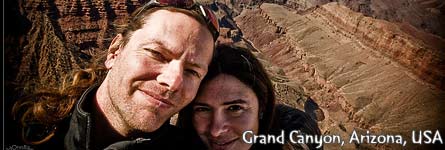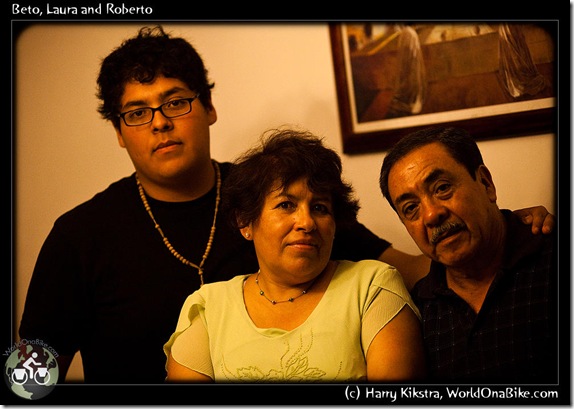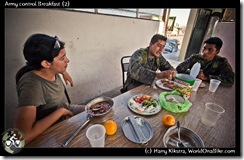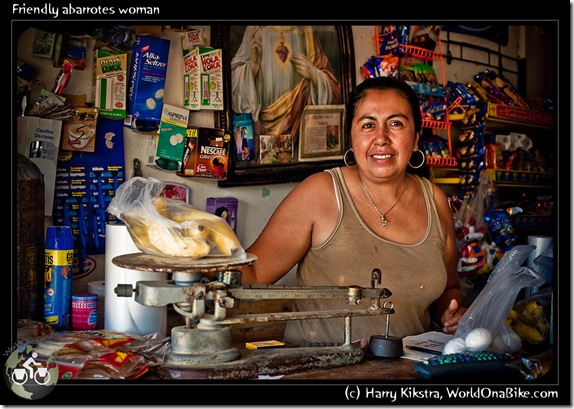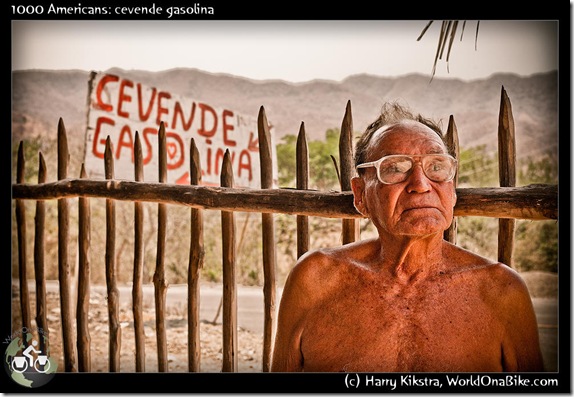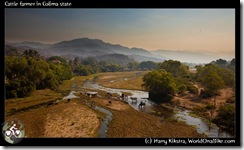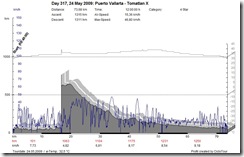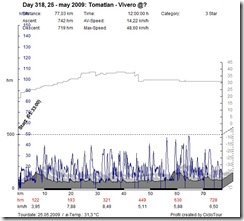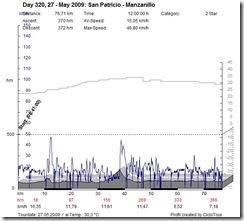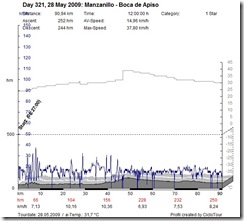1000 Americans: Roberto and family, Metepec, Mexico
September 14, 2009 by Harry
Filed under 1000 Americans
Roberto, his wife Laura and son Beto (Roberto) live in Metepec, a small place under the smoke of bigger cities Toluca and Mexico City. Roberto has worked for the government for several decades, riding 2 buses every day to get to work.
They sold part of the family land, thus creating a new modern ‘barrio’, a neighbourhood, but they still enjoy their vegetable garden in the back of the house.
Day 322-324, 29-31 May 2009: Hospitals, drunk rides and beach camps
September 12, 2009 by Harry
Filed under Trip reports, Tips & Tricks, North America, Mexico, Central Mexico
29th May 2009: Boca de Apisa – Maruata: 30km cycling, 2 rides, 3 hospitals, free breakfast, lunch and campsite on the beach
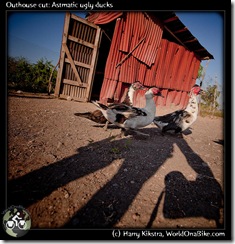 Ivana has a problem with birds. When they fly far away or sing cheerfully in the morning, she loves them, but when they get within her personal space they scare her. So when she had to go to the outhouse, where not only a toilet, but also half a dozen very ugly asthmatic ducks were to be found, she called in the troops.
Ivana has a problem with birds. When they fly far away or sing cheerfully in the morning, she loves them, but when they get within her personal space they scare her. So when she had to go to the outhouse, where not only a toilet, but also half a dozen very ugly asthmatic ducks were to be found, she called in the troops.
To chase the ducks away I walked around the toilet, but suddenly the rotten wood bottom gave away.
I did not know how deep the hole was nor what I would find inside, but as gross scenes from Slumdog Millionaire flashed through my mind, I instinctively held on to the side of the outhouse. 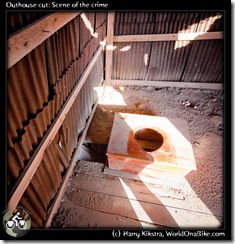
Unfortunately whomever build this construction had decided at some point that it would be better to use nails that are too long, rather than not long enough and my arm got stuck on the end of a nice long and rusty one. As I was still gravity-assisted and going down, it ripped my skin open, holding on to a few cm (1”).
While the bleeding slowly started I walked back out towards Ivana and told her I had cut my arm. The farmer had just come in as well and told us that the army checkpoint on the nearby road had a small hospital, so off we went.
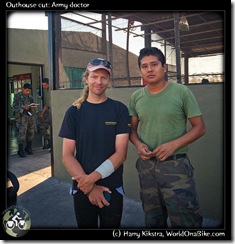 The Army doctor took a look and took me outside to clean the wound thoroughly with a healthy dose of pure stinging alcohol and a lot of pressure. As a small part of the skin was missing, he said that stitches probably would not work. He covered it with bandages, gave me some antibiotics and recommended to get a tetanus injection soon. Next patient please.
The Army doctor took a look and took me outside to clean the wound thoroughly with a healthy dose of pure stinging alcohol and a lot of pressure. As a small part of the skin was missing, he said that stitches probably would not work. He covered it with bandages, gave me some antibiotics and recommended to get a tetanus injection soon. Next patient please.
His fellow soldiers –they check cars and trucks for weapons and drugs- were interested in our trip and when we came back after packing our bikes they invited us for breakfast. We had had our breakfast half an hour before, but a real Bike Traveller never declines food.
We got some tortillas and beans, some meat and fresh juice, served with some nice chats about their work and our trip. To top it off they brought in a chilled guanabana, a large fruit with white flesh that was incredible tasty.
Even though I had some tetanus shots over a year ago in Argentina, a rusty nail in an duck-filled outhouse appeared to me the ultimate test that I did not want to fail, so it seemed like a wise idea to get another shot; there should be a hospital in the small village down the road.
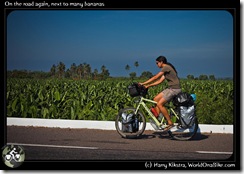 The village turned out to be quite big, noisy and polluted and off the road, but with some help we found the hospital, where I was given the tetanus shot right away. Back to the road again, through a nice flat section lined with banana trees.
The village turned out to be quite big, noisy and polluted and off the road, but with some help we found the hospital, where I was given the tetanus shot right away. Back to the road again, through a nice flat section lined with banana trees.
The next section was not just very hilly, but also known for its bandits and drug-traffickers, who use the small beaches on the rugged coasts to land their smuggling boats. We had planned to get a ride through this section as all the mafia apparently had attracted road-side robbers, attacking vehicles on the quiet road.
First we had to find a good place to hail a pick-up for a ride:
- The perfect spot is near a ‘tope (toh-pay)’, the annoying bumps that are placed on the road to slow down traffic. Cars have to almost stop here and it is easy to ask for a ride.
- If you are on a Quota/toll road, then the toll-both is perfect as well, assuming the guards let you stand there to ask.
- Near a corner, as most (not all) vehicles slow down in a curve, and we can see in time if it is a car or a full pick-up truck as it is no use to stop a car or a pick-up without space for our bikes.
- With sufficient open space for our bikes to be parked near the road and for the car to brake and pull-out.
- Not in a zone known for carjacking, drug trafficking & highway robbers as hitchhikers will be considered possibly dangerous and the cars offering a ride might be as well.
None of the above were available and while looking for them, the road started climbing without mercy. My arm hurt a lot when pulling at the handlebars at steep sections as there was tension on the fresh wound. Ivana’s knee was hurting again as well, so we just started asking passing cars while pushing our bikes up the steep slopes.
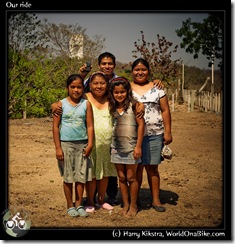 To our surprise a young girl, alone in a big pick-up, stopped and took us and our bikes. We picked her brother up on the way and they took us to their house, where their mum immediately invited us for lunch, treating us to quesadillas and avocado, yum!
To our surprise a young girl, alone in a big pick-up, stopped and took us and our bikes. We picked her brother up on the way and they took us to their house, where their mum immediately invited us for lunch, treating us to quesadillas and avocado, yum!
We could have camped with them, but wanted to get a bit further, so we headed back to the main road and pointed our thumbs towards the sky near a small road-shop.
After several hours of trying, alternating turns in the hot sun, a car truck stopped that could take us to Maruata, which sounded fine to us. What was less fine was that several cases of beer were emptied during the trip and while the road was curvy and bumpy, the speed picked up considerably.
We were sitting in the back with our bikes and were relieved when we arrived near the small town. The first thing we noticed was a huge new building, that turned out to be a newly-opened hospital. Perfect timing, as I wanted to change my bandages and check if my cut had not been infected. We walked in the near-empty building. It was dark as the night-nurses did not know yet where the main light switches were.
A friendly nurse cut away the bandages, took an interested glance at the nasty-but-not-infected-looking wound and then started scrubbing it with half a bottle of iodine using all of her force, suddenly looking a lot less charming.
While I was painfully getting cleaner than the brand new hospital floor, a 14 year old girl walked in crying, fully pregnant and about to deliver. We both looked at her and her crazy mother (or grandmother?) that just laughed like nothing was wrong in this picture. Again I realized the luxury that my so-called ‘problems’ would almost always be smaller than those seen around me.
When checking the prescription the doctor had written out for me, we noticed it was the same as the antibiotics we already had and so we left the 3rd hospital today without paying anything. All the treatments including the tetanus injection had been free of charge. Not just for me as a lucky tourist, but for everybody. Only if I had wanted to buy medication, I would have had to pay. How is that for a ‘developing country’?
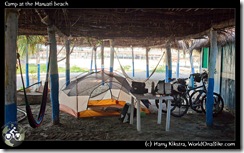 We cycled safely through the dark towards the beach on a bumpy trail, thanks to our headlights on our Santos bikes. Maruata beach is actually quite famous; for the surf and the turtles and it is simply pretty.
We cycled safely through the dark towards the beach on a bumpy trail, thanks to our headlights on our Santos bikes. Maruata beach is actually quite famous; for the surf and the turtles and it is simply pretty.
Now it was dark, but a few guesthouses and restaurants offered some light as well as some food and free camping. A couple of friendly salesmen that also had stopped here for the night offered to pay a room for us, but we explained that we rather be outside in our tent, as it would be cooler and without mosquitoes.
We fell asleep while the surf provided a lazy rhythm to the lightshows of the fireflies. Wat een dag!
30 May 2009: Maruata beach – Caleta de Campo: crazy hills, drunk rides and more beach
Our friendly host suddenly requested money for the free camping after all, but gave in after a brief protest from our side. We headed back up to the road and started cycling, again looking for a great place for our next ride.
There was none. This section of road was insane, a succession of incredibly steep climbs, directly followed by deadly downhills through blind corners on a narrow road with temperatures going through the roof. Rinse and repeat several dozen times. We now realized why the distance on the map had seemed wrong, but was right after all: if you could take this road and stretch it out, it would cover the true distance at least twice.
It would destroy the knees of Lance Armstrong, if he were able to get a fully loaded bike up here. So likely it would ruin ours as well and as the doctor had ordered rest for my arm we resorted to stopping pick-ups to force our next ride through this overheated madness.
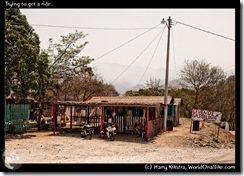 IOf course few people use this road for long-distance and it would take 5 separate rides that day before we would get to our next stop: one friendly guy, a drunk couple that picked us up twice, a trio of young girls in an expensive new truck and a nice man that turned out to be a drunk idiot as well, tossing out an empty beer can out the window every few minutes.
IOf course few people use this road for long-distance and it would take 5 separate rides that day before we would get to our next stop: one friendly guy, a drunk couple that picked us up twice, a trio of young girls in an expensive new truck and a nice man that turned out to be a drunk idiot as well, tossing out an empty beer can out the window every few minutes.
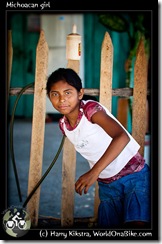 We still managed to cycle about 50km ourselves that day and even spend our lunchtime waiting several hours for a ride at a small place in the middle of nowhere where small kids were cycling downhill on a bike without brakes without wearing shoes, for fun.
We still managed to cycle about 50km ourselves that day and even spend our lunchtime waiting several hours for a ride at a small place in the middle of nowhere where small kids were cycling downhill on a bike without brakes without wearing shoes, for fun.
There we also got to chat with Orlando, an 80-year old Mexican that had great knowledge about geography and mountains all over the world. He was clearly very well educated, but now he just waited in the shade for his next customers: in exchange for free food and lodging, he sold gasoline for a local lady. Using his mouth and a hose he transferred the fuel into the expensive cars that stopped by, realizing that fuel stations were a rarity on this road.
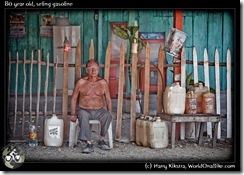 We saw his eyes gleam when we told him about our trip, but our heart broke every time he spent minutes coughing and spitting after every filling-up of yet another car filled with rude people. It was a sad sight, especially with the wrongly spelled ‘Cevende Gasolina’ sign on the road behind him (‘Se vende Gasolina = Gas for sale).
We saw his eyes gleam when we told him about our trip, but our heart broke every time he spent minutes coughing and spitting after every filling-up of yet another car filled with rude people. It was a sad sight, especially with the wrongly spelled ‘Cevende Gasolina’ sign on the road behind him (‘Se vende Gasolina = Gas for sale).
The last drunk ride had dropped us off in a beach town and a steep but paved road dropped us right onto the beach. Ivana was exhausted so I went to check the places to camp. 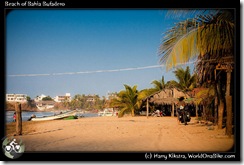 All the restaurants wanted cash to camp on their empty properties, even if we would buy dinner there. In the end the only place that would let us camp, was one that had the kitchen closed.
All the restaurants wanted cash to camp on their empty properties, even if we would buy dinner there. In the end the only place that would let us camp, was one that had the kitchen closed.
So we settled for a few emergency noodle soups and bought some cold beers to thank our hosts and quench our thirst Next door a children’s party hit a piñata (as well as one unfortunate small guest) to smithereens while thousands of small to medium-sized crabs that had appeared out of nowhere crawled around my feet, headed for the ocean. World On a bike in Mexico…
31 May 2009: Caleta de Campo beach – Uruapan: 80km + 200km in rides, up to the highlands!
The road had turned sane again and as our injuries felt better, we decided to make some more miles by ourselves again. The coastal road was a lot nicer here, with a fresh breeze coming up from the pretty beaches and hills that were doable for mortals.
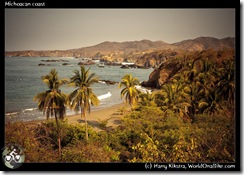 We did try to use ‘lunch’ -the hottest time of the day- for getting another ride as we were now less than one month away from our deadline in Cancun, so all bits would help.
We did try to use ‘lunch’ -the hottest time of the day- for getting another ride as we were now less than one month away from our deadline in Cancun, so all bits would help.
The small town was full of pick-ups, but it turned out that was just for the local fiesta, which in itself turned out to be a cockfight, illegal in the USA, a quite regular Sunday outing in Mexico.
Ivana talked to and helped some local kids that were trying to inflate a bicycle tire. Soon after they came up to me with their broken derailleur and a handful of parts. Though it had been a while since I fixed a derailleur as our Rohloff system has internal gears instead, I managed to turn into Bicycle Repairman and got all the parts connected and the gears going again.
I noticed that the initial joy on the little guy’s face had suddenly disappeared.
‘Comocuantovaser?’, he spoke swiftly but softly with a worried look on his face.
 Como cuanto va ser, or ‘how much is it going to be?’, we translated. Poor guy, he was afraid that the gringo would charge him a lot for fixing his bike.
Como cuanto va ser, or ‘how much is it going to be?’, we translated. Poor guy, he was afraid that the gringo would charge him a lot for fixing his bike.
I explained him that it was free and that cyclists should always help each other out when needed and his face cleared up to reveal a bright smile.
Closer to the larger city of Lazaro Cardenas we got 2 short rides across the busiest sections and they dropped us off at the new ‘quota’, the toll road that was not on our 2 maps. We cycled some more along the road, assuming we would at some point encounter a tollbooth.
We noticed that there was almost no trash near the road, a clear sign that it was just opened recently, as all other roads in Mexico are lined with plastic, glass, paper, more plastic and styrofoam. As friendly as the Mexicans are, their own environment is one thing they do not seem to care about. When cycling you really see the extent of the influence of plastic waterbottles & chips: free roadside marketing that shows that thousands of Coca-Cola drinkers have no respect for nature, not even their own.
When we finally got to the crossing where the booth was, some soldiers advised us not to go further east, but inland instead to visit Morelia and to enjoy the cooler air. We looked at our map and decided that it might be a good idea to head for the fresh highlands instead of following the bumpy hot coastline to Acapulco first.
The first pick-up Ivana asked already had some bags in the back, but still agreed to take us all the way to Uruapan. And so within minutes we speeded up on a brand-new road through the steep hills of the highlands, ending up nearly 1800m higher in the fresh world capital of avocado’s.
 The driver and his wife had planned to drop us off near a gas station, but intrigued by our little business-card they decided to invite us in their house instead.
The driver and his wife had planned to drop us off near a gas station, but intrigued by our little business-card they decided to invite us in their house instead.
We had a pleasant evening with the family Mendez. Again we ended up staying freshly showered and well-fed in the clean beds of new friends, wondering what the highlands of Central Mexico had in store for us…
1000 Americans: Family Mendez, Uruapan
September 12, 2009 by Harry
Filed under 1000 Americans
This friendly couple sells fertilizer for the many avocado farmers in Uruapan, Mexico. The area is the ‘aguacate’ capital of the world: the fruits -known as ‘a(d)vocado’ or ‘palta’ elsewhere- grow on all the hills, timed to perfection when all the other avocado producers in the world have no fruit to sell.
1000 Americans: Armando & Mariana, Mexico
September 12, 2009 by Harry
Filed under 1000 Americans
Armando & Mariana live in a grand house near Manzanillo, Mexico. They had lived in the US for a long time before and was highly appreciated by his US boss, who wanted to keep him for the company by helping with the necessary papers. Just before his papers were ready, Armando had to return to Mexico to take care of his parents, so it took a while before he could come back to the States.
Now all is arranged and regularly they visit their friends and relatives in the US, but always return to their native grounds, Mexico, to enjoy their mango trees, the outside kitchen and the chilli pepper-eating parrot.
1000 Americans: Shopkeeper in Mexico
September 12, 2009 by Harry
Filed under 1000 Americans
Mexico is filled with little ‘Abarrotes’: tiny shops, usually containing with food, water and all kinds or useful and less useful articles. Mostly the shops are connected to the house of the owner, so if there is nobody, just shout and somebody will come out to assist.
This friendly lady was a single mom, but with many plans, to extend and re-paint her shop, so she could keep her kids in school. She helped us with free water and we bought some great sweet bread and bananas to support the education of Mexico’s future.
1000 Americans: Orlando, 80-year old gasoline seller, Mexico
September 12, 2009 by Harry
Filed under 1000 Americans
We got to chat with Orlando, an 80-year old Mexican that had great knowledge about geography and mountains all over the world. He was clearly very well educated, but now he just waited in the shade for his next customers: in exchange for free food and lodging, he sold gasoline for a local lady. Using his mouth and a hose he transferred the fuel into the expensive cars that stopped by, realizing that fuel stations were a rarity on this road.
We saw his eyes gleam when we told him about our trip, but our heart broke every time he spent minutes coughing and spitting after every filling-up of yet another car filled with rude people. It was a sad sight, especially with the wrongly spelled ‘Cevende Gasolina’ sign on the road behind him (‘Se vende Gasolina = Gas for sale).
1000 Americans: Mexican family, Pacific Coast route, Mexico
September 12, 2009 by Harry
Filed under 1000 Americans
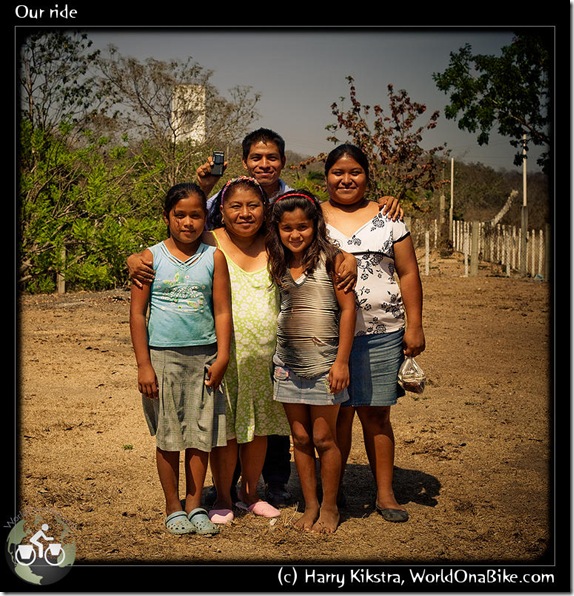 While father never escaped the attraction of the TV–screen in the living room and never even acknowledged our presence, Mother is showing that she is proud of her children who live with her in a small dusty town near the Pacific coast, but go to school and college inland.
While father never escaped the attraction of the TV–screen in the living room and never even acknowledged our presence, Mother is showing that she is proud of her children who live with her in a small dusty town near the Pacific coast, but go to school and college inland.
1000 Americans: flower grower in Mexico
September 12, 2009 by Harry
Filed under 1000 Americans
South of Mexico City, a lot of flowers are grown, many for export, this is one of the growers/farmers we met on the way.
Day 317-321, 24-28 May 2009: hot hilly roads, tropical fruits and friendly Mexicans
September 10, 2009 by Harry
Filed under Trip reports, North America, Mexico, Central Mexico
After our trip across the Sea of Cortez it was time to cross terra firma again. Only we were still not sure which route to take. It was clear that we would never make it in time to Cancun, to meet our mums, so what to do? 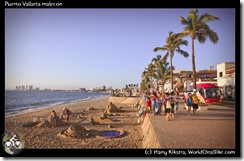
We decided to visit Puerto Vallarta first, as we could not believe that that such a famous place (The Love Boat!) would be nothing more than a collection of ugly resorts and polluted highways.
Our persistence paid off when we cycled over the cobbled streets of old Vallarta and onto the nice Malecon, the boardwalk. There were plenty of people about, artists, friendly beggars, loads of tourists, sand sculptors and even a set of oriental rope artists circling down from their platform.
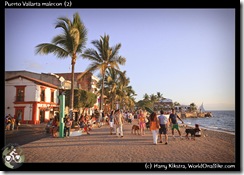 It was all nice, but it was also getting dark and we had no idea
It was all nice, but it was also getting dark and we had no idea
- where to go to, from Vallarta,
- where to sleep…
- and, most alarming of all: we did not have dinner yet!
As usual the solution to all questions presented itself without too much effort from our side. Just when we were checking our map of Central Mexico, a couple sat down next to us and asked about our bikes and trip.
 When I asked them in return about the different route possibilities – there is no straight way inland, you can go North and then East through Guadalajara, or South along the coast and then North again- they were sure that the coastal route was the best option: flat, narrow but quiet and only a few sections with drug-traffickers and other accompanying bandits. Sweet.
When I asked them in return about the different route possibilities – there is no straight way inland, you can go North and then East through Guadalajara, or South along the coast and then North again- they were sure that the coastal route was the best option: flat, narrow but quiet and only a few sections with drug-traffickers and other accompanying bandits. Sweet.
Cool, number 1 solved, and number 2 & 3 followed smoothly when they invited us for dinner and to stay in their house near the Malecon. Mexico is so full of friendly people, it looks like a complete different country than the media makes it out to be. Actually it is. Much, much better, as was and would be proven time and time again.
Day 317, 24 may 09: Puerto Vallarta – Near Tomatlan: 74km. Jungle to desert…
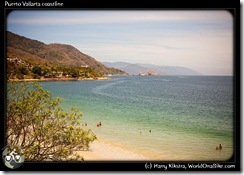 The next morning we were treated to nice tropical fruits for breakfast, pineapple and papaya! Real vitamins!
The next morning we were treated to nice tropical fruits for breakfast, pineapple and papaya! Real vitamins!
It was early but hot, but the coastal route was quite shady and showed us the hidden gems of the Vallarta Bay: nice beaches, amazing mansions and boutique hotels and lush jungle and fruit trees. 180 degrees difference from the dry desert of Baja California and even the rollercoaster road could not spoil our joy.
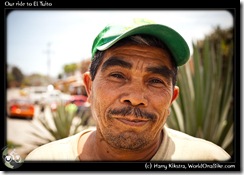 That is, until the road turned sharply and went both inwards as upwards. The cool sea-breeze dropped and the temperature rose 10+ degrees within minutes, the jungle turned to desert and the road into a narrow steep wall with little space for our bikes. Our map showed that this would continue to 750m (2500ft) up, which did not seem like a great idea for our knees and general life expectancy, so we decided to take a lift, the first of many short ones along the Mexican South Coast.
That is, until the road turned sharply and went both inwards as upwards. The cool sea-breeze dropped and the temperature rose 10+ degrees within minutes, the jungle turned to desert and the road into a narrow steep wall with little space for our bikes. Our map showed that this would continue to 750m (2500ft) up, which did not seem like a great idea for our knees and general life expectancy, so we decided to take a lift, the first of many short ones along the Mexican South Coast.
Our friendly driver dropped us off at the top of the hill in El Tuito, stopping his ramshackle pickup only once on the way up, to buy some soft drinks for us, not accepting our money for it.
After lunch in the pueblito, we got to enjoy a nice downhill through pine forests and then a mix of dried shrubbery and other desert vegetation. We felt back in the Baja, seems that the Vallarta bay had been a one-off paradise. Soon the heat became unbearable, but though the Pacific Ocean should be near, no sign of it was noticeable, definitely no refreshing breeze.
The sun burned without mercy on yours trulies riding the undulating road and we had to stop several times for some shade, as well as to refill our bottles. We ended up just before sunset at a crossing close to the town of Tomatlan.
In Baja, it always cooled down at sunset, but over here, it still seemed to get hotter even. As we needed more water and it cost the same as a huge bag of ice, we solved two problems at once, cycling around the village with a large plastic bag with ice cubes, watched by curious Mexicans.
We found a friendly woman that would let us camp in her garden and even though we only put up our inner tent, it was so hot that we went to bed covered with nothing than our Ortlieb water bags and polarbottle, filled with the melting ice in a futile attempt to cool off…
It was still more than 30 degrees outside; the stupid guard dogs did not know whether to protect or attack us and the man of the house that returned drunk in the dark first fed bananas to the goats, and went back to the bar, only returning a short while later to vomit loudly in his car while abusing his helping wife. Life on a bike, always different, never far from reality.
Day 318/9, 25/6 may 09: Rollercoasting from Tomatlan to San Patricio 77+41km, 1400m up and down.
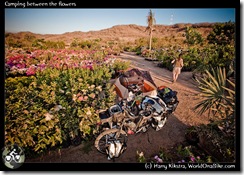 Just when we were mixing our newly discovered freeze dried soy-milk with cereals, a full-size truck pulled up at the gasstation. In the back stood more than 2 dozen kids, ranging in age from 8 to about 17. Innocent and naive as we were, we thought that this might be a poor-man’s version of a school bus, either to take the kids to school or to an excursion, as it was a weekday.
Just when we were mixing our newly discovered freeze dried soy-milk with cereals, a full-size truck pulled up at the gasstation. In the back stood more than 2 dozen kids, ranging in age from 8 to about 17. Innocent and naive as we were, we thought that this might be a poor-man’s version of a school bus, either to take the kids to school or to an excursion, as it was a weekday.
When Ivana asked the kids where they were going, the just replied with slent blank stares and took off again. The attendant explained that they were off to work in the fields, to produce the cheap fruit for export. No education for these and many other kids in Mexico, the only thing they learn is to work, and work hard.
We hit the ‘coastal road’ again but caught exactly one glimpse of the Pacific; most of the time we were just sweating up and down the few dozen smaller and bigger hills. Nothing too serious, just annoying in the sweltering heat.
Again the average temperature was above 31 degrees and we were happy that the friendly gardener that let us camp in his flowery vivero, offered us use of his garden hose and water-tank to freshen up at the end of the day.
An early start gave some refreshment, but after 35km –including already 700m/2300ft up !- it was hotter than ever and we started to curse our friendly Vallarta host that had recommended this ‘flat coastal’ road that was neither, and which we doubted he had ever been on. He definitely never had cycled it in his life.
Time for lunch, and things improved considerably when we stumbled on a nearly-deserted guesthouse, with swimming pool, fruit-dropping mango trees and an internet cafe. Heaven! Of course our lunch lasted longer than planned and we decided to camp here, being offered more mangos than we could eat. Life was not so bad after all.
Day 320, 27 May 2009: San Patricio – Manzanillo 76km, 370m up and down
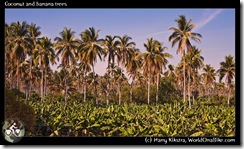 We had entered the state of Colima, which we had been dreaming about since we found out that a large part of Mexico’s fruit originates here. We were not disappointed, as the bumpy desert abruptly had given way to fields of coconut palms, mango trees and banana trees, while smaller orchards and roadside stalls offered all kinds of other natural goodies.
We had entered the state of Colima, which we had been dreaming about since we found out that a large part of Mexico’s fruit originates here. We were not disappointed, as the bumpy desert abruptly had given way to fields of coconut palms, mango trees and banana trees, while smaller orchards and roadside stalls offered all kinds of other natural goodies.
 A few women were chopping enormous piles of brown coconuts in half; they only collected part of the fruit for the cosmetic industry, discarding both the juice as well as the tasty heart, so we filled up our bottles rather than letting the healthy water flow onto the thirsty sand.
A few women were chopping enormous piles of brown coconuts in half; they only collected part of the fruit for the cosmetic industry, discarding both the juice as well as the tasty heart, so we filled up our bottles rather than letting the healthy water flow onto the thirsty sand.
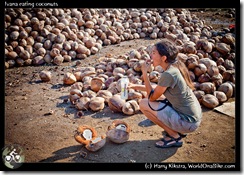 There were many mango trees with thousands of fruits dropped onto the forest floor. Apparently due to the transportation and export (to the US) hassle and cost, it is too costly to harvest and sell them so they just rot away. Except the ones that fitted in Ivana’s big Ortlieb bag of course 🙂
There were many mango trees with thousands of fruits dropped onto the forest floor. Apparently due to the transportation and export (to the US) hassle and cost, it is too costly to harvest and sell them so they just rot away. Except the ones that fitted in Ivana’s big Ortlieb bag of course 🙂
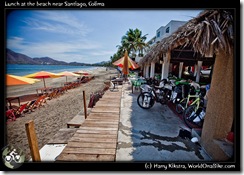 As an added bonus, the road was nearly flat and we not only got to see the ocean, we even got to touch it when stopping for lunch near a nice swimming beach.
As an added bonus, the road was nearly flat and we not only got to see the ocean, we even got to touch it when stopping for lunch near a nice swimming beach.
What goes up has to come down, even when not literally, and things deteriorated seriously after lunch. Traffic increased to annoying numbers when we approached the busy city of Manzanillo. Lack of signs made us follow a dead end street to the harbour for several km. Noise and exhaust of the buses, cars and freight trains rose to lethal levels and to top it, we got into a huge fight about which route to take. In the end I gave in and up and let Ivana decide, resulting in another detour of several kilometres.
After 75km we were more than exhausted and while still angry we rung the doorbell on a house that had a big gate and a nice garden; both necessary for a safe camp in an urban zone.
 An elderly couple opened up and listened to our story. Soon they invited us, not just for dinner, but also to use one of the extra rooms upstairs, so instead of fighting and sweating in our tent, we got a shower, Mexican food and a ventilator to cool us down.
An elderly couple opened up and listened to our story. Soon they invited us, not just for dinner, but also to use one of the extra rooms upstairs, so instead of fighting and sweating in our tent, we got a shower, Mexican food and a ventilator to cool us down.
We deserved it.
Day 321, 28 May 09, Manzanillo – Boca de Apisa, 91km
 The fruity flatness continued and though the average temperature was above 31C/ 88F again, it was still a relatively pleasant ride though the field, only interrupted by a few hours of lunch in a truck-stop to avoid the heat and a short visit to the ugly City of Tecoman.
The fruity flatness continued and though the average temperature was above 31C/ 88F again, it was still a relatively pleasant ride though the field, only interrupted by a few hours of lunch in a truck-stop to avoid the heat and a short visit to the ugly City of Tecoman.
We were aiming straight for some nasty looking hills, but turned right before reaching them, back to the direction of the Ocean. We did not notice that our total recorded distance had silently increased to a 5-figure number until later that night, 10,000km (6250mi) on the road!
We had been looking forward to camping on the beach, but when we followed the 5km/3mi long turnoff, we discovered that the road literally ended at the ocean, with just a few meters of sand separating us from the big powerful waves.
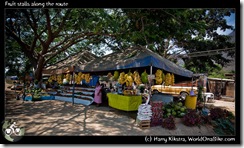 Armed with nothing much more than the knowledge that we had entered drug-trafficking country we were not being overly comfortable with the stares of some local youth and the lack of water and safe places.
Armed with nothing much more than the knowledge that we had entered drug-trafficking country we were not being overly comfortable with the stares of some local youth and the lack of water and safe places.
So, tired as we were, we headed back up to the main road and asked a farmer if we could pitch a tent on his land, which was situated next to a military checkpoint.
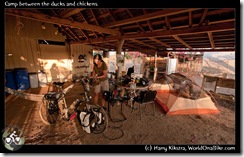 As there were dozens of different feathered friends around, Ivana preferred to camp under the roof. After being chased into our hot tent by a battalion of nasty mosquitoes, we fell into a restless sleep, blissfully unaware of the fact that I would visit 3 different doctors in 3 different hospitals in the next 24 hours…
As there were dozens of different feathered friends around, Ivana preferred to camp under the roof. After being chased into our hot tent by a battalion of nasty mosquitoes, we fell into a restless sleep, blissfully unaware of the fact that I would visit 3 different doctors in 3 different hospitals in the next 24 hours…
Kowalski! Status report!
 Mangos eaten: countless
Mangos eaten: countless- Metres climbed in 5 days on the ‘flat coastal road’: 2500+
- Average temperature during those 5 days: 31C/88F.
- Km cycled since Prudhoe Bay, Alaska: 10,020!
- Vertical meters/climbed since PB, AK: 83,460 (52 miles)
- Santos Travelmaster problems: zero.
- Knee & back report: positive, taking care and working fine.
Here are the road profiles, for those masochistic enough (or smart enough to cycle this in winter) to take it on:
1000 Americans: Coconut cutter in Mexico
September 10, 2009 by Harry
Filed under 1000 Americans
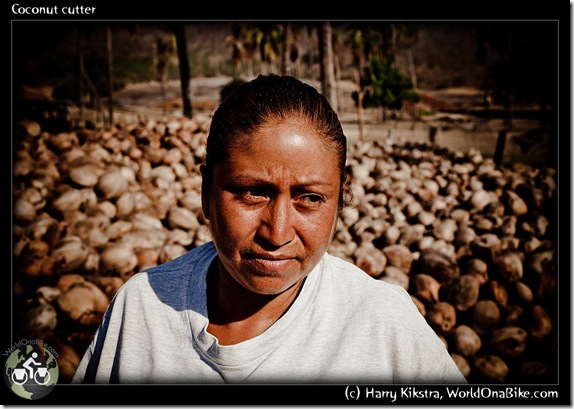 Hiding under a tarp for protection against the strong sun, Deolinda slowly cut her way through the pile of thousands of brown coconuts in front of her using a big axe.
Hiding under a tarp for protection against the strong sun, Deolinda slowly cut her way through the pile of thousands of brown coconuts in front of her using a big axe.
The juice was thrown away, as only the coconut oil in the meat is interesting for the cosmetics companies that ultimately are responsible for hiring and underpaying her.


